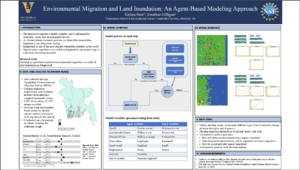2019 CSDMS meeting-012: Difference between revisions
No edit summary |
No edit summary |
||
| Line 41: | Line 41: | ||
{{CSDMS meeting abstract template 2019 | {{CSDMS meeting abstract template 2019 | ||
|CSDMS meeting abstract=Migration is a complex phenomenon that is impacted by economic, social, cultural, and environmental factors. This complexity makes it challenging to study, and especially challenging to understand how future environmental and climatic change may affect mobility and population movements. Agent-based modeling (ABM) is a promising but underutilized method for studying environmental impacts on human migration because of its ability to study connections between large-scale dynamics and individual decision-making. This work presents initial results from an original ABM that simulates household migration decisions in Bangladesh under environmental pressure. The model seeks to understand how riverbank erosion and land inundation impact mobility patterns under varying decision-making frameworks and livelihood opportunities. The model stochastically simulates inundation of land bordering a river. Agents whose land is flooded seek employment in a local labor market. Agents who cannot find employment within the community then face the decision to migrate or remain in the community with limited economic opportunity. We compare several different decision frameworks of varying complexity, in which the probability of choosing to migrate depends upon: household wealth alone, wealth, age, and household size, and finally using the Theory of Planned Behavior, which incorporates interactions between individual-level variables and community-level phenomenon, such as social norms, which are mediated through each agent’s social network. This model serves as a starting point to begin to test how different decision-making frameworks and environmental scenarios may produce different dynamics in the response to environmental stress. | |CSDMS meeting abstract=Migration is a complex phenomenon that is impacted by economic, social, cultural, and environmental factors. This complexity makes it challenging to study, and especially challenging to understand how future environmental and climatic change may affect mobility and population movements. Agent-based modeling (ABM) is a promising but underutilized method for studying environmental impacts on human migration because of its ability to study connections between large-scale dynamics and individual decision-making. This work presents initial results from an original ABM that simulates household migration decisions in Bangladesh under environmental pressure. The model seeks to understand how riverbank erosion and land inundation impact mobility patterns under varying decision-making frameworks and livelihood opportunities. The model stochastically simulates inundation of land bordering a river. Agents whose land is flooded seek employment in a local labor market. Agents who cannot find employment within the community then face the decision to migrate or remain in the community with limited economic opportunity. We compare several different decision frameworks of varying complexity, in which the probability of choosing to migrate depends upon: household wealth alone, wealth, age, and household size, and finally using the Theory of Planned Behavior, which incorporates interactions between individual-level variables and community-level phenomenon, such as social norms, which are mediated through each agent’s social network. This model serves as a starting point to begin to test how different decision-making frameworks and environmental scenarios may produce different dynamics in the response to environmental stress. | ||
|CSDMS meeting posterPDF= Kelsea Best_CSDMS Conference Poster final.pdf | |||
|CSDMS meeting posterPNG= Kelsea Best_CSDMS Conference Poster final.png | |||
}} | }} | ||
{{blank line template}} | {{blank line template}} | ||
Latest revision as of 07:55, 28 May 2019
Log in (or create account for non-CSDMS members)
Forgot username? Search or email:CSDMSweb@colorado.edu
Browse abstracts
Environmental Migration and Land Inundation: An Agent-Based Modeling Approach
Migration is a complex phenomenon that is impacted by economic, social, cultural, and environmental factors. This complexity makes it challenging to study, and especially challenging to understand how future environmental and climatic change may affect mobility and population movements. Agent-based modeling (ABM) is a promising but underutilized method for studying environmental impacts on human migration because of its ability to study connections between large-scale dynamics and individual decision-making. This work presents initial results from an original ABM that simulates household migration decisions in Bangladesh under environmental pressure. The model seeks to understand how riverbank erosion and land inundation impact mobility patterns under varying decision-making frameworks and livelihood opportunities. The model stochastically simulates inundation of land bordering a river. Agents whose land is flooded seek employment in a local labor market. Agents who cannot find employment within the community then face the decision to migrate or remain in the community with limited economic opportunity. We compare several different decision frameworks of varying complexity, in which the probability of choosing to migrate depends upon: household wealth alone, wealth, age, and household size, and finally using the Theory of Planned Behavior, which incorporates interactions between individual-level variables and community-level phenomenon, such as social norms, which are mediated through each agent’s social network. This model serves as a starting point to begin to test how different decision-making frameworks and environmental scenarios may produce different dynamics in the response to environmental stress.

